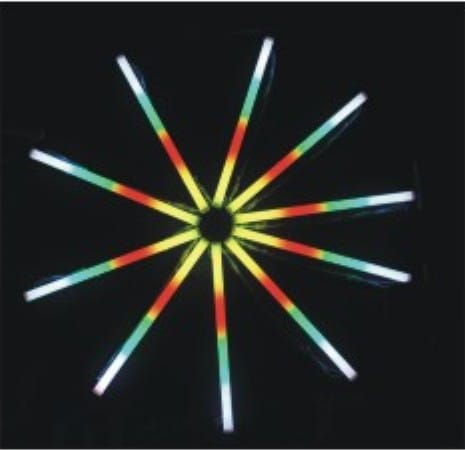LED Products for the entertainment market
There are so many advantages

LED (Light Emitting Diode) technology in the professional entertainment market has been on a fast track in the entertainment industry for the last six years after originally being introduced at the 1997 LDI show (http://www.ldishow.com/) to a crowd that often yawns at unproven technology. It was then that Color Kinetics, a Boston company broke new ground by merging microprocessor control and a network address with LEDs to create and pioneer several new intelligent solid-state lighting devices. Armed with a multi-million dollar Research and Development program and patent upon patent, Color Kinetics brought the entertainment industry into the LED lighting revolution.
I remember the time during which we were building our new warehouse space in November, 2003 and the representatives from Color Kinetics came by our temporary office with a couple of cases of solid state intelligent LED products to demonstrate. For the most part they were prototypes and some of them didn’t make the airline flights too well but they were really different from anything on the market and they quickly captured my attention. On one hand, they didn’t put out much light, were fragile, packaged for consumer use rather than touring, did not have independent white light and were simply odd shaped. On the other hand, they didn’t require dimmers, used very little amperage and changed colors instantly. Did I mention they were expensive? It was to be expected. Even though they were truly a full step above everything else on the market from a technological standpoint, the consumer grade packaging made them unusable for touring, outdoor presentations and one-off event production.
In the ensuing years, Color Kinetics licensed their technologies to almost every big name player in the entertainment business and in doing so became the dominate force in the industry of solid state intelligent LED illumination. They became a public corporation in late 2006 and were purchased by Philips in June 2007 for almost $800 million. The merged entity now operates under the name Philips Solid-State Lighting Solutions, with intelligent and premium LED product lines ultimately co-branded Philips/Color Kinetics.
Armed with this new resource Philips was the first company to submit an entry in the L Prize, a U.S. Department of Energy contest to create a viable LED-based alternative to a standard 60-watt light bulb. In May 2008, the Department of Energy announced that it would award $10 million to the first company that developed a solid-state lamp that could replace a standard bulb. The lamp can use no more than 10 watts to create the equivalent light of a 60-watt incandescent bulb; the color of the light output had to mimic that of an incandescent and the bulbs must last at least 25,000 hours, as much as 25 times as long as today’s standard bulbs.
While you and I might think $10 million would make a good start in creating a really over-the-top Christmas display for our entire neighborhood, Philips is not in it for that prize. The contest winner will, no doubt, get access to potentially lucrative federal purchasing agreements and hope to replace millions of bulbs in both the residential and commercial markets.
General Electric has also made public its plans for the future of the light bulb with this June 2009 announcement.
GE Consumers & Industrial and GE Global Research have suspended the development of the high-efficiency incandescent lamp (HEI) to place greater focus and investment on what we believe will be the ultimate in energy efficient lighting — light emitting diodes (LEDs) and organic light emitting diodes (OLEDs). Research and development of these technologies is moving at an impressive pace and will be ready for general lighting in the near future. LEDs and OLEDs used in general lighting are now poised to surpass the projected efficiency levels of HEI, along with other energy-efficient technologies like fluorescent, and have the additional benefits of long life and durability.
Currently, there is interesting research being done with OLED (Organic Light Emitting Diode) which is a carbon based technology; hence the name “organic”. Wikipedia describes OLED as An organic light emitting diode (LED) whose emissive electroluminescent layer is composed of a film of organic compounds. The layer usually contains a polymer substance that allows suitable organic compounds to be deposited. They are deposited in rows and columns onto a flat carrier by a simple “printing” process. The resulting matrix of pixels can emit light of different colors.
OLEDs are not as efficient as the now standard LED, but they are much simpler to manufacturer and the color is reported to be even purer than a standard LED. One big advantage from their inherent thinness is that they can be made flexible. I don’t pretend to know how this technology works but I can understand the potential uses of such as explained by people in the industry who keep abreast of these changes. OLED are rumored to be the next generation of LEDs offered in cell phone, camera and MP3 player displays, screens used for television reception, computer monitors, etc. The technology has already demonstrated that it can be made into flexible wall surfaces and even clothing so we can include architecture and fashion to the industries in which OLED will be made available in the future. Yes, the world of lighting is changing and Edison would be proud of the progress.
What does all of this have to do with Christmas lights? With the future of the Edison light bulb seemingly headed into obsolescence and toward LED dominance, the choices of LED lighting for Christmas displays will increase and the cost will decrease. With any luck maybe Phillips, GE, Osram or another manufacturer will actually make LED or OLED Christmas lights that more homeowners can afford in the not too distant future. Then, no one will be able to escape those beautiful synchronized displays thumping out Wizards In Winter at 105 decibels with the full color spectrum in virtually every city in the United States. Interestingly, GE has already shown an OLED Christmas tree to showcase their research in this technology.
Let’s take this opportunity to enjoy where the R&D by Color Kinetics has led the industry and take a look at a few LED fixtures used in general entertainment lighting. This market is inevitably where technology finds its way in the early stages of development after an initial visit with the beta testers on Broadway and at Disney. The next stop is the consumer market on every street, USA. It isn’t that far away as one only has to take a quick glance at various threads in the PlanetChristmas forums to see how creative and innovative people can become in their endeavors.
The following LED products can be categorized in a few general areas although there are certainly many variations within these categories. Looking at two mid-quality manufacturers product lines; Elation (www.elationlighting.com) and Chauvet (www.chauvetlighting.com), we can find fixtures made with LEDs including strip lights, wall washers, moving yoke fixtures, tube lights, panel lights, flood and spot type par lights, flexible ribbon lights, moving mirror fixtures, tape lights and disco effect lights. Although I have omitted examples in the list below, both manufacturers have an architectural line of product as well which tend to be more expensive and weatherproofed to a greater degree. It should be noted that there are many manufacturers which sell product of different quality than the examples offered, yet it is likely that many products throughout the pricing spectrum will soon find their way into Christmas displays.
This article was included in the November 2009 issue of PlanetChristmas Magazine.
By Charles Belcher




